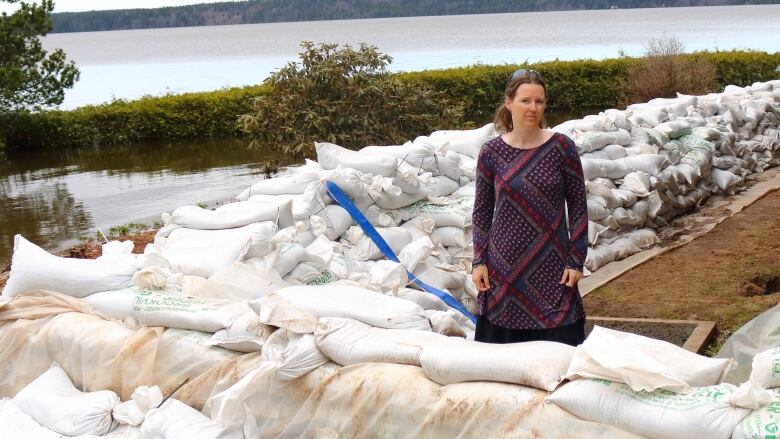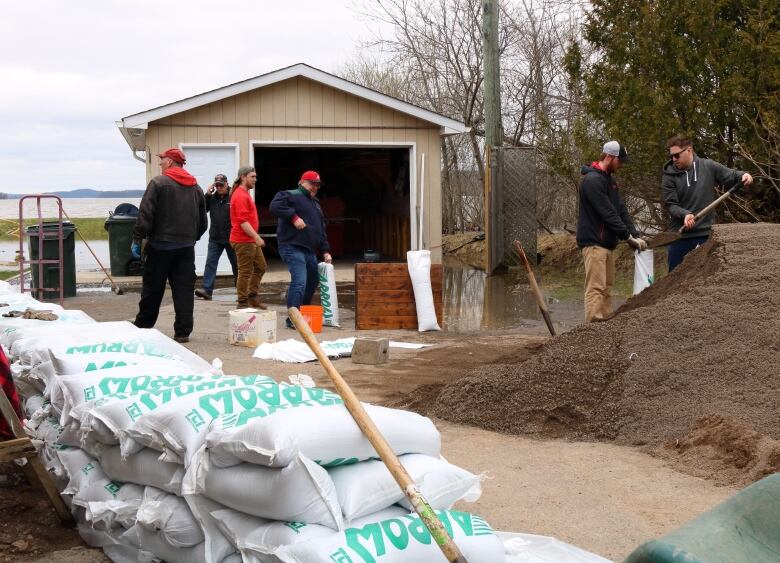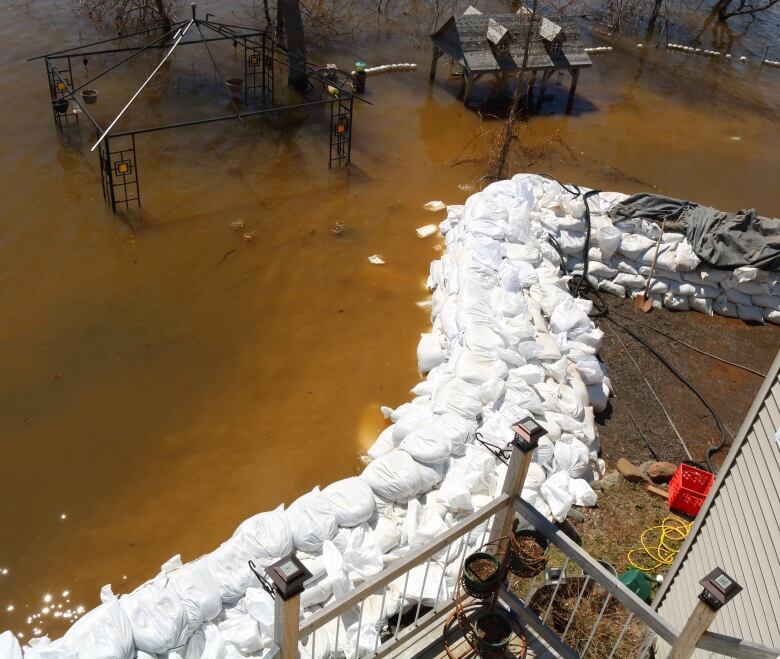The house is safe. Now what do you do with all of those sandbags?
Sandbags disposal is the next major challenge facing New Brunswick after historic 2018 flood

Half a million sandbags close to 10,000 tonnes of sand have been distributed across New Brunswick since severe flooding inundated the province almost two weeks ago.
That doesn't count bags filled by homeowners, by volunteers, or bypoliticiansduring photo-ops.
Flood prevention efforts are continuing throughout the Saint John region. Thank you again to all those lending a hand to friends and neighbours in any way they can. pic.twitter.com/iInjws7t3a
—@BrianGallantNBNow that the water levels are receding, disposing of sandbagssaturated with "heavilycontaminated" flood waterwill be the next major flooding-related challenge.
The process will involve potential health risks, strenuous physical labour, and a massive influx of waste into provincial landfills.
Bound for the landfill
Many people assumed that sandbags could be dumped out and used as fill, on driveways,or in your garden.
That isn't the case, according to the Department of Environment and Local Government.
The public has been cautioned to avoid contact with floodwater, which could contain human waste, fuel, broken glass andbacteria. According to the World Health Organization, direct contact could cause "wound infections, dermatitis, conjunctivitis, and ear, nose and throat infections, diarrheal, vector- and rodent-borne diseases [as well as] respiratory, skin and eye infections."

All that applies to sandbags that have been sitting in the river.
"In order to be disposed of properly, sandbags should be sent to the regional service commission landfills," said department spokesperson Anthony Doiron.
According to the province, sandbags should not be emptied into the water or within 30 metres of any watercourse or regulated wetlands, where the alien material could threaten wildlife.
"That bacteria, which really can have an impact on human health, are in the bag and in the sand," said Lois Corbett of the Conservation Council of New Brunswick. "So the last thing you want to do is to put that pollution back into the system."

Sandbags that have clearly been contaminated with other substances will require additional steps, according to Ryan Donaghy, the acting assistant deputy minister in the Department of Environment and Local Government.
"Contact the Department of Environment if they've clearly been contaminated by oil and gas," Donaghy said. "These may need to be disposed of by a different remedial company."
What cities are doing
We had these floods, everything is threatened, many people lost everything and now there are thousands of sandbags that are contaminated to deal with.- Sharon Murphy-Mayne, flooded homeowner
Individual cities, towns, and local service districts are expected to organize special solid waste collection dates specifically for sandbags.
In Saint John, one of the areas hard-hit by the flood, communications officer Lisa Caissie said: "We are working on recovery plans and details will be provided as they are available."
The province said it would release details in coming days about the disposal of sandbags and hazardous materials such as petroleum and propane tanks, chemical containers anddrowned animals.

'This is going to be a nightmare'
The sandbag stress is real for Sharon Murphy-Mayne of Rothesay.
To protect their home overlooking theKennebecasisRiver, Murphy-Mayne, her family, and a crew of volunteers spent four days last week laying 2,300 sandbags they purchased, plus another 2,000 from the Town of Rothesay.
"The final count is 5,000," she said. Almost all of the bags, she said, have been filled beyond the recommended 44-pound load.

"They're between 50 and 60 [pounds]," she said. "And now they're wet, so more than that."
When they built the structure, they were thinking about saving their house . It was an emergency."
So what happens now?
"We're not sure," she said. She's considering somehow landscaping around the bagsbut isn't sure yet how that would work.
"Anyone who is compromised physically, elderly people, the lot, it's going to be a nightmare for them," she said.
"We had these floods, everything is threatened, many people lost everything and now there are thousands of sandbags that are contaminated to deal with that they can't lift."
A lifelong environmental activist, Murphy-Maybe didn't want to think about the possibility of all that sand ending up in a landfill.
"That would be an awful option," she said.
Longer lineups, longer hours
Itmay be the safest option, according to Fundy Region Solid Waste Commission general manager Marc MacLeod.
"If it's been touched by the water, the general rule is that it may have some sort of contamination in it whether it's coliform, human waste, petrochemicals, those sorts of things,"MacLeod said. "You just don't know. It's safer to dispose of them."
The woven polypropylene bags are not biodegradable or recyclable.

Once sandbags arrive at the landfill, MacLeod said, they'll be buried.
"At the end of the day, it's all going to get up in the landfill and take up space. That's how it is."
Ten thousand-plus tonnes of sand, however, will be "taxing" on provincial landfills, to say the least.
To put things in perspective, 10,000tonnesof sand represents abouthalf the tonnage of residential waste generated by the entire greater Saint John area in all of 2014.
"There's going to be longer lineups, there's going to be longer hours," MacLeod said. "[We're] running extended hours for five weeks. It's taxing on the system and the staff. They're going to be working 12-hour days just like everyone else."
But the Fundy region commission is working on a plan, he said. "If you're going to ask me if we can handle it, the answer would be yes."
Military could help
As anyone who's built a sandbag wall can imagine, dismantling one is no mean feat.
Wet bags, which must be handled using gloves and boots, are easy to slip or trip over. They usually contain a mixture of coarse grains, which can cause scratches and abrasions. Some also may contain clay mixed with sand.
The Canadian Armed Forces will be performing a reconnaissance mission to see what, if any, role it can play during during the flood recovery in New Brunswick, Premier Brian Gallant announced Thursday.
Later, Public Safey Minister Ralph Goodale confirmed the federal government will provide support, including military aid, to the flood relief effort.

After the 2017 floods in Ottawa and Gatineau, municipalities called in the military for help with hazardous waste disposal.
The sandbag load, MacLeod said, is unlike anything New Brunswick has seen during prior flooding, including 2008.
Landfills "weren't taxed [in 2008] to the point where we had to have a separate classification called 'sandbags,'" he said. "It just didn't happen. We know it's going to happen this time."
"Just the sheer volume of sandbags as high as 500,000 those numbers weren't there in 2008," he said.
"Which speaks to the size of this event."












_(720p).jpg)


 OFFICIAL HD MUSIC VIDEO.jpg)
.jpg)



























































































